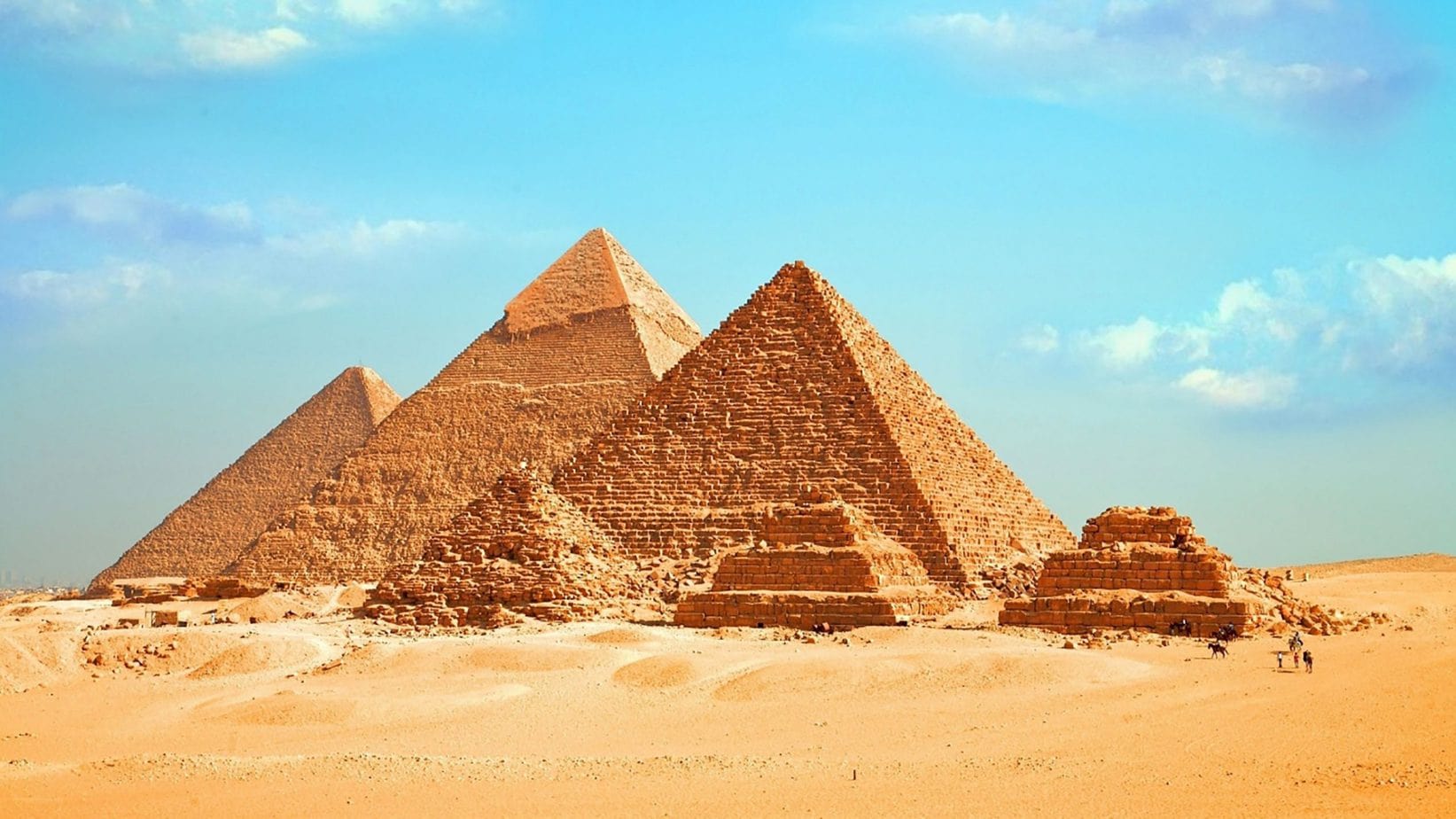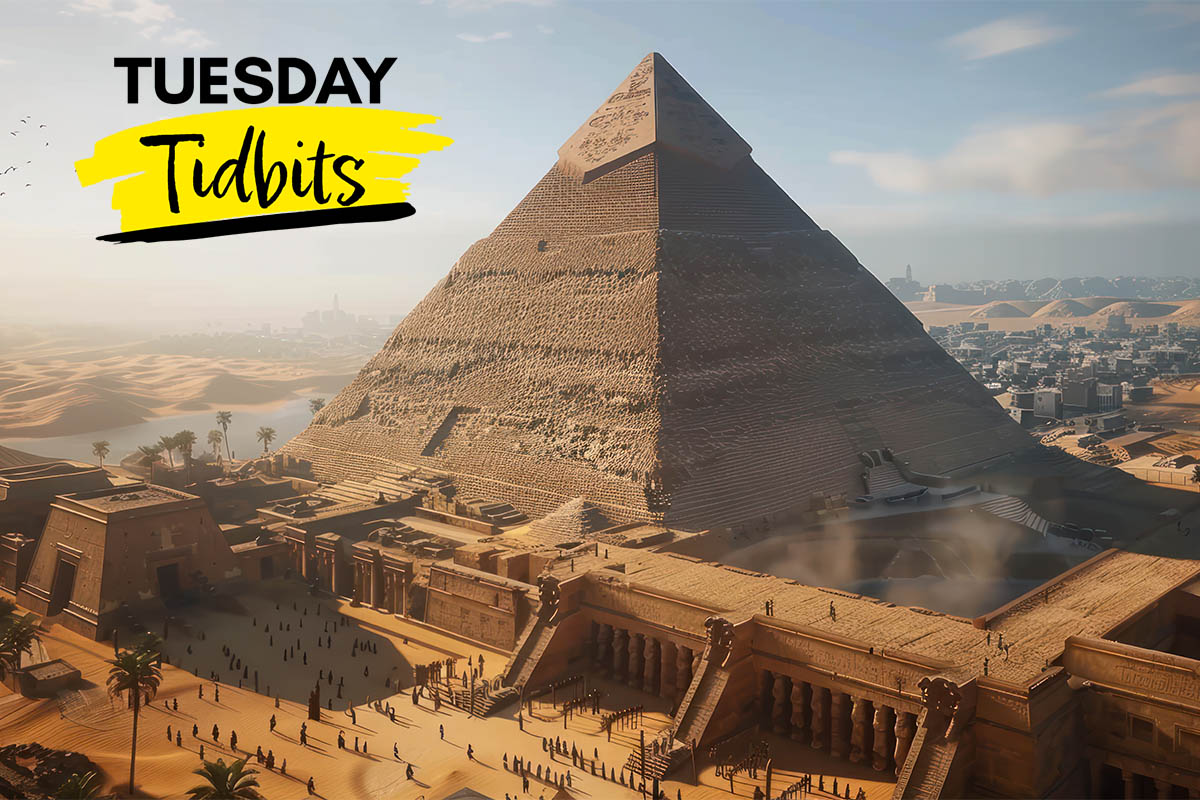The Egyptian pyramids of Giza are some of the most impressive manmade structures in the history of our planet. It’s estimated that they were built over 4,500 years ago with over two million stones over a period of 20 to 30 years.
The Great Pyramid is the largest of the three Giza Pyramids, built for each of three pharaohs—Khufu, Khafre, and Menkaure. Khufu’s pyramid is the largest ever constructed in Egypt, standing 481 feet (146 m) tall when it was first built. Ancient writers considered it a wonder of the world.
Have you ever surmised the number of ancient Egyptians it took to build these architectural wonders or how they cut the monstrous blocks of stone and moved them into place? You’re not alone! With all of the extensive research that has been performed, even archeologists can’t agree. As such, the construction of the pyramids remains a mystery. And unfortunately, the Egyptians seem to have purposefully left no record of how they accomplished their herculean task.
The Ramp Theory
Most Egyptologists believe that, based on the evidence thus far, The Ramp Theory offers the most plausible explanation for how the ancient Egyptians constructed the pyramids. The Ramp Theory suggests that the pyramids were made with sheer manpower and tens of thousands of workers via a method known as “ramp systems.” But at the same time, there are different theories about what types of ramps would have been used.
Some experts have theorized that ancient Egyptians utilized straight ramps that went up the pyramid’s outside walls. Then again, other experts believe that the pyramid builders utilized either ramps that curved around these walls or ramping systems that were built inside the pyramids themselves.
In 2018, archaeologists discovered the remains of an ancient ramp system in the 4,500-year-old Hatnub quarry in the Eastern Desert of Egypt that they believed offered a definitive explanation of how ancient Egyptians built the pyramids. According to archaeologists from the Institut français d’archéologie orientale (French Institute for Oriental Archaeology) in Cairo and from the University of Liverpool in England, the system would have been used to transport heavy alabaster stones up a steep ramp. And, it was possibly the methodology by which Egyptians built the Great Pyramid in the name of the pharaoh Khufu. The only problem with this theory is that the Giza pyramids were built of granite, not alabaster.
The Ramp System
The Ramp System was composed of a central ramp flanked by two staircases with numerous post holes. Using a sled that carried a stone block and was attached with ropes to the wooden posts, ancient Egyptians were conceivably able to pull the alabaster blocks out of the quarry on very steep slopes of 20 percent or more, according to researchers from the University of Liverpool and Cairo’s French Institute for Oriental Archaeology. The ropes attached to the sled would have acted as a “force multiplier,” which would have made it easier for workers to pull the sled up the ramp. Such a design would have alleviated some of the burden for the workers who had to pull these huge loads.
There may have been several ramps on each side of the pyramid at different levels, and a ramp may have been coiled around the pyramid as it grew in height. Once a stone block reached its desired level, wooden rockers may have been used to maneuver it into position.
This theory is supported by the fact that sleds are well documented in ancient wall paintings, as are images of giant statues being pulled by hundreds of men. It would, however, have been a very time-consuming process.
Moving the Stones into Place
How the Egyptians moved the stones to the pyramid construction site is also a mystery. A wall painting discovered in the ancient tomb of Djehutihotep, which dates back to about 1900 B.C., depicts 172 men hauling an immense statue using ropes attached to a sledge. In the drawing, a person can be seen standing on the front of the sledge, pouring water over the sand, said study lead author Daniel Bonn, a physics professor at the University of Amsterdam.
It is theorized that the water made it easier for sleds that carried the massive granite stones to be dragged across the desert sand to the pyramid construction sites. Adding water to the sand would have increased the stiffness of the sand, and the sleds would have been able to glide more easily across the surface. This is because droplets of water create bridges between the grains of sand, which helps them stick together. It is also the same reason why using wet sand to build a sandcastle is easier than using dry sand.
So… How Exactly Did They Build the Pyramids?
Even with all of these findings and evidence, Egyptologists remain perplexed. They continue to seek evidence that would definitively explain how ancient Egyptians cut, moved, and placed into position the massive stones that were used to construct the pyramids.









The book THE PYRAMIDS, AN ENIGMA SOLVED clearly has a VERY plausible explanation. They were built with slip-forms using a concrete-like slurry that was poured on all four+ sides simultaneously. Why is this not researched further. Evidence is astounding to the slurry technique.
Yes, some pyramids were built with quarried stone and ramps, but the massive pyramids could be built in record time with slip-forms.
One might note that we have postulated that Egypt was covered with sand the way it is today. This is a rather large presumption since the entire North African ecosystem was devastated by the introduction of camels and subsequent overgrazing. Also, Biblically, Egypt had 7 years of plenty followed by 7 years of drought – this in itself could have had some significant ecological effects. Finally, Josephus writes about Moses’ campaign as an Egyptian General. In this campaign, he marches South to Luxor to expel the Ethiopians (Queen of Saba). He is successful because he takes a little used route. This route is infested with vipers and scorpions. Moses overcomes this obstacle by releasing scorpion/snake eating birds (probably storks or secretary birds) to forage in front of the army. According to Josephus, no soldiers were lost due to snake or scorpion bites. Factoid: Storks and Secretary Birds are grassland inhabitants.
Anti-gravity coupled with other high-tech devices from UFOs is another plausible theory…..? Sure wish
WE knew the answer but another question is why were so many other pyramids built around the world? Cheers.
Most of the blocks are made of limestone, not alabaster or granite.
all baloney. pure conjecture. idiocy, really.
The Egyptians did not use mile long ramps, they did not use internal ramps and they certainly did not float them into position with goat skins filled with air. They used gravity
The internal ramp is the best theory because you wouldn’t waste any resources
Even with all of these findings and evidence, Egyptologists remain perplexed. They continue to seek evidence that would definitively explain how ancient Egyptians cut, moved, and placed into position the massive stones that were used to construct the pyramids.
Just do a google search for DDCpyramid construction method The DDC will show you how it is done using excavation a down ramp and sand remember if you can’t build what is on the inside then the construction method being used is incorrect
What follows has been known since 2006 via university research, however only Pravda in Moscow published the article titled “The Documented Ancient Construction Method of The Great Pyramid”. Pravda placed the article on the London Global News Exchange in 2019 where it was ignored, or perhaps avoided.
Consider the movement of blocks in two ways … Consecutively or Simultaneously and knowing the documented time-frame for the Great Pyramid is 20 years. Logistics of Engineering can only accommodate the SIMULTANEOUS movement of blocks which absolutely rules out consecutive and thus rules out ALL ramp and water shaft-canal theories.
The method used is known today as Rack & Pinion Mechanical Technology and the Egyptians developed its prototype at Giza. Those hundreds of limestone steps you observe for all Giza Pyramids are RACKS, over all four sides and height.
Inty Shedu was the carpenter in chief at Giza and fabricated LOBES made from short planks of Cedar which had been imported from Lebanon as we know via the “Palermo Stone”. Evidence for the “four lobe pinion pulley” is the “Petrie rocker” excavated in 1895 by Edouard Neville and handed to Petrie in person for his London museum.
The Shedu four-lobe pinion-pulley is a machine of Class Two Lever Principle, Pivot-Load-Effort, same as a forward wheel, wheel-barrow, and has a mechanical advantage of 2.8 (MA=2.8) which means a 2500 kg Pyramid block can be raised with an input effort of 900 kg. Search haitheory
The engineering logistics of CONSECUTIVE traffic of blocks raised within the documented twenty year time-frame rules out ALL ramp and water-shaft canal theories which all have “one block follows another’ illogical approach. Blocks were moved SIMULTANEOUSLY over all those STEPS you see of all Giza Pyramids. Four-lobe pinion-pulleys were used on and over ALL available horizontal STEP surface area. Hoist one block per hour over an eight hour day. Forty pulleys, ten per side, raise 320 blocks.
Over a year, 365 days 116,800 blocks are raised. Over Twenty years 2,336,000 blocks have been raised. The method is known in our modern world as Rack and Pinion mechanical engineering. Those hundreds of limestone STEPS can be termed RACKS. The Pinions were fabricated from imported Lebanese Cedar timber under the supervision of Chief Carpenter Inty Shedu who was entombed on the Giza Plateau. Inty Shedu’s four tomb statues are exhibited in the Cairo museum. The Shedu Four-Lobe Pinion-Pulley has an innate mechanical advantage of 2.8 (MA=2.8) which means a 2500kg Pyramid block is raised with an input effort of 900kg. Search haitheory website and haitheory at YouTube.
OK The frist thing that must besaid is that there is no upramp no matter were you put it on the structure is going to help you create the Grand Gallery
and mechanical atvantage from a pully system would come up short..
the GG has 20 ton stones stacked one on top of the other at a 26 DEGREE ANGLE..
There is not one person that can show the reader how to build the GG walls .. Let it be said that the DDC Pyramid Construction Method is not interested in
any degrees or professioal labels.. The fact remains every other method fails.. Therefor if the DDC can show the reader how this can be done in a tangable world Then it should be be seen as a method and demand merit..
A very long deep pit is built running north to south to the middle of the structure..this pit would be filled with sand to which the blocks will be placed apon both walls would be built at the same time being that the GG ramp has already been built this is the 26 degree foundation that the wall blocks will rest apon..
Sand is like a dry hydrulic can be hard as concreate yet flow like water..Fill a coke can with sand and try to crush it and still can be pord out like water..
So by carefully undermoinding the sand under the block they could lower the block floating the block into place without having to have ropes running under the block for suport that they would not be able to reteive once set into place
The DDC’s claim to fame is this was all made possible WITHOUT LIFTING A BLOCK…
noone ever takes on the challange of proving me wrong by showing me a more logical way..
The DDC is correct. time and the lack of evdence will tell..
Alan Christ